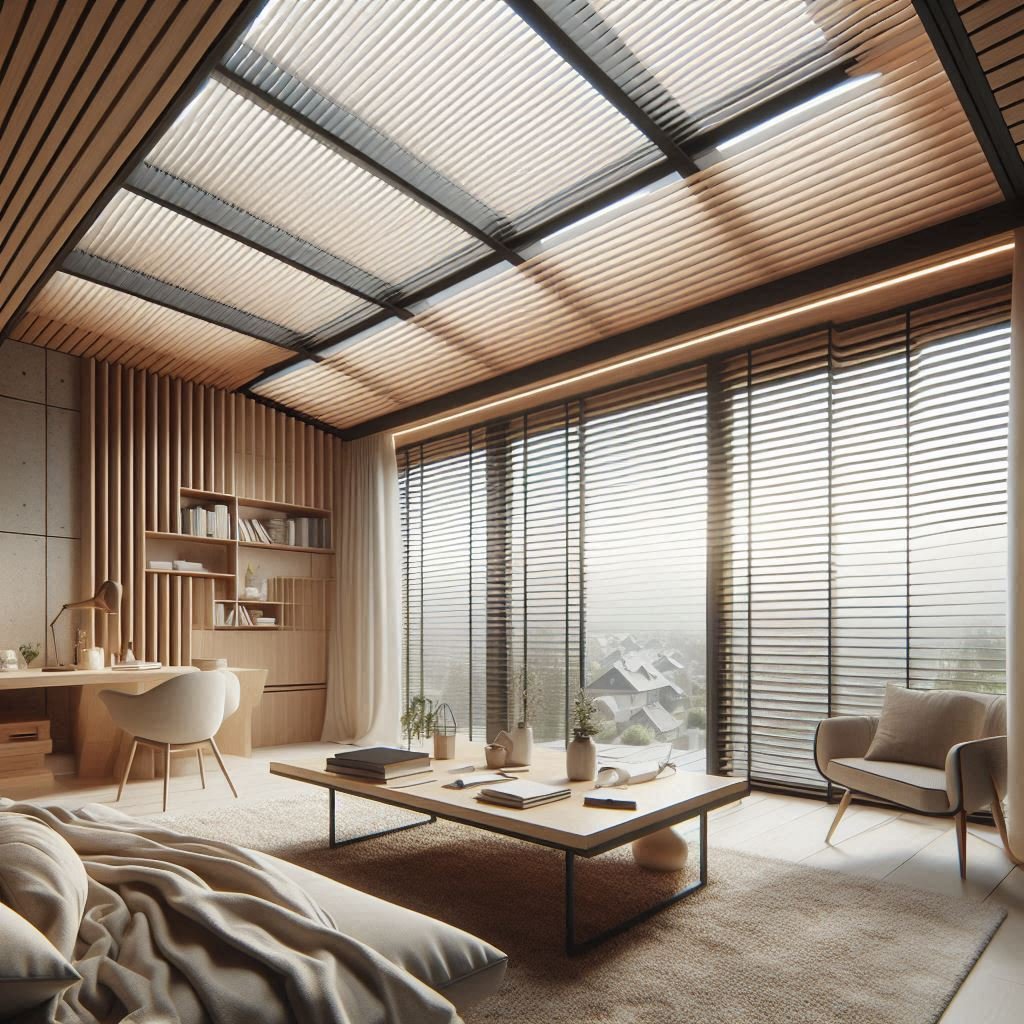Why Smart Blinds Are Essential for Modern Smart Homes

Smart blinds do more than just block sunlight, they also enhance comfort, protect your furnishings, and seamlessly integrate into your smart home automation system. With features like motorized blinds that adjust automatically based on light, temperature, or time of day, electric roller blinds and remote control blinds eliminate manual operation, providing a hassle-free solution for modern living.
What are Smart Blinds and How Do They Work?
Smart home blinds are motorized window coverings that offer a convenient and efficient way to control natural light and privacy in your home. These innovative blinds can be operated remotely using a smartphone app, voice commands, or integrated into a larger smart home system.
A typical smart blind system consists of a motor, a control system, and a variety of blind or curtain materials. The motor powers the movement of the motorised blinds, while the control system allows you to adjust them to your desired position. The type of material used for the electric blinds can vary, from sheer fabrics to blackout shades, offering different levels of light control and privacy.
Types of Smart Blinds: Comparison Table
| Smart Blind Type | Key Features | Best For | Example |
|---|---|---|---|
| Smart Roller Blinds | Sleek design, remote or app-controlled, available in various materials, automated schedules | Living rooms, offices, bedrooms where light regulation is important |  Check on Amazon |
| Electric Blackout Blinds | Blocks 100% of light, perfect for privacy, voice-controlled, scheduled automation | Bedrooms, home theaters, nurseries |  Check on Amazon |
| Remote Control Blinds | Controlled via dedicated remote without the complexity of a full smart home system. Available, available in various styles, battery or plug-in options | People seeking easy-to-use window treatments without smart home integration |  Check on Amazon |
| Motorised Vertical Blinds | Perfect for large windows or sliding doors, adjustable slats, remote-controlled | Large windows, sliding glass doors, spaces needing privacy and light control |  Check on Amazon |
| Motorised Roman Blinds | Elegant design, controlled via app or remote, fabric folds, can integrate into smart home systems | Living rooms, dining areas, bedrooms needing a stylish solution |  Check on Amazon |
| Motorised Venetian Blinds | Adjustable slats for precise light control, remote and app-controlled, available in various materials | Offices, living rooms, kitchens for flexibility in light control |  Check on Amazon |
| SmartSKY Blinds | Cutting-edge smart blinds, designed specifically for roof-lights. Ideal complement to modern glass architecture, automated based on sunlight or temperature | Skylights, ceiling windows, and modern glass architecture |  Check on Amazon |
Advantages and Disadvantages of Smart Blinds:
| Advantages | Disadvantages |
|---|---|
| Enhanced Convenience: – Remote control via smartphone or voice assistant – Automated schedules for optimal lighting | Higher Initial Cost: – Smart home blinds can be more expensive than traditional blinds or shades. – Potential for increased energy consumption if not used efficiently. |
| Improved Energy Efficiency: – Reduced energy consumption by optimizing natural light and temperature control – Lower energy bills | Reliance on Technology: – Requires a stable Wi-Fi connection and compatible smart home system. – Potential for technical difficulties and malfunctions. |
| Enhanced Security: – Simulated occupancy to deter intruders – Remote monitoring of your home | Maintenance Requirements: – May require regular software updates and maintenance. – Potential for wear and tear on the motor and other components over time |
| Improved Aesthetics: – Sleek, modern design – Customizable to match any interior design style |
A Step-by-Step Guide to Smarter Living
Installing smart blinds can significantly elevate your home’s comfort and efficiency but while many smart home blinds can be easily installed by a DIY enthusiast, some complex installations may require professional assistance.
- Before You Begin:
- Choose Your Smart Blinds: Select the type of smart blind that best suits your needs and style, such as roller shades, Venetian blinds, or panel track systems.
- Measure Accurately: Measure your windows to ensure a perfect fit. Consider any obstructions like window handles or deep recesses.
- Gather Your Tools: Prepare the necessary tools, including a drill, screwdriver, level, and measuring tape.
- DIY Installation:
- Mount the Brackets: Securely attach the mounting brackets to your wall or window frame using a level to ensure they are straight.
- Install the Headrail: Carefully slide the headrail into the brackets, ensuring it’s level and secure.
- Attach the Blinds: Follow the manufacturer’s instructions to attach the blind material to the headrail.
- Connect to Power: If your electric blinds require a power connection, ensure it’s done safely.
- Pair with Your Smart Home System: To control them remotely download the manufacturer’s app and follow the instructions to connect your blinds to your Wi-Fi network or Bluetooth devices.
- When to Seek Professional Help:
- Complex Installations: If you’re dealing with large, custom-sized blinds or intricate window configurations, consider hiring a professional installer.
- Lack of DIY Experience: If you’re unsure about your DIY skills, a professional can handle the installation efficiently.
Smart Blinds Maintenance: A Guide to Longevity and Performance
To ensure your smart blinds continue to function flawlessly and enhance your home’s aesthetics, regular maintenance is key. Here’s a comprehensive guide to keep your smart home blinds in top condition:
- Regular Cleaning
- Fabric Blinds: Gently vacuum with a brush attachment to remove dust. For stubborn stains, use a mild detergent and a damp cloth.
- Wooden Blinds: Wipe with a soft, dry cloth. Avoid using harsh chemicals or excessive moisture, as this can damage the finish.
- Troubleshooting Common Issues
- Connectivity Problems: Ensure your motorised blinds are within your Wi-Fi network’s range. If issues persist, try resetting the device or consult your user manual.
- Battery Life: Monitor battery levels and replace them when necessary to avoid interruptions.
- Mechanical Issues: Handle your blinds gently and avoid forcing them into positions. Regular inspections can help identify and address any potential issues early on.
- Manufacturer’s Recommendations
- Consult the Manual: Always refer to your specific smart blind’s user manual for detailed care instructions.
- Professional Maintenance: For complex issues or professional cleaning, consider hiring a qualified technician
Integration with Smart Home Systems
Smart home blinds revolutionize window treatments by seamlessly integrating with popular smart home ecosystems. Control them effortlessly through smartphone apps or voice commands with platforms like Alexa, Google Assistant, and HomeKit. Connect them to a central hub for unified control alongside other smart devices. For instance, when integrating with voice assistants you can enjoy voice control features for your smart blinds. By issuing simple commands like “Close the living room blinds,” you can quickly adjust the ambiance of your home space without the need for a traditional remote or manual operation. You can as well schedule routines to automate the lowering or raising of the motorised blinds at specific times based on your preferences and daily basis life style.

To understand the integration capabilities with other devices, we suggest to read the articles “Smart Home Security“, “Smart Home Lighting” or “Smart Home Locks” which will give you an idea about other smart home devices and the integration capabilities with them.
Moreover, the potential for synchronization with other smart devices amplifies the benefits of smart blinds. For instance, when combined with smart lighting systems, users can create a dynamic environment—the motorised blinds can be programmed to lower as the lights dim, promoting an inviting atmosphere for evening relaxation. In conjunction with smart thermostats, automatic adjustments of your smart home blinds can help regulate indoor temperatures, thereby enhancing energy efficiency. Popular products that are compatible with these systems include the Lutron Serena Shades and the IKEA FYRTUR, which exemplify how smart blinds can elevate any home automation strategy.
Conclusion: A Smarter Home, A Brighter Future
Smart home blinds have emerged as a game-changing addition to modern homes, offering a blend of style, functionality, and energy efficiency. By seamlessly integrating with your smart home system, they provide a level of convenience and control that was once unimaginable. The practicality of smart home blinds lies in their ability to adapt to your daily routines. For instance, programmable schedules can ensure that your blinds open to let in natural light during the day and close in the evening for privacy. Bear in mind that It’s very important to explore the market available options before embarking on the final installation of smart blinds.
In conclusion, embracing smart home blinds is a decision that enhances not just the functionality of your home, but also enriches your overall lifestyle. We encourage readers to delve deeper into this subject and evaluate how smart blinds can best serve their specific needs, ultimately paving the way for a more efficient and enjoyable living experience.
